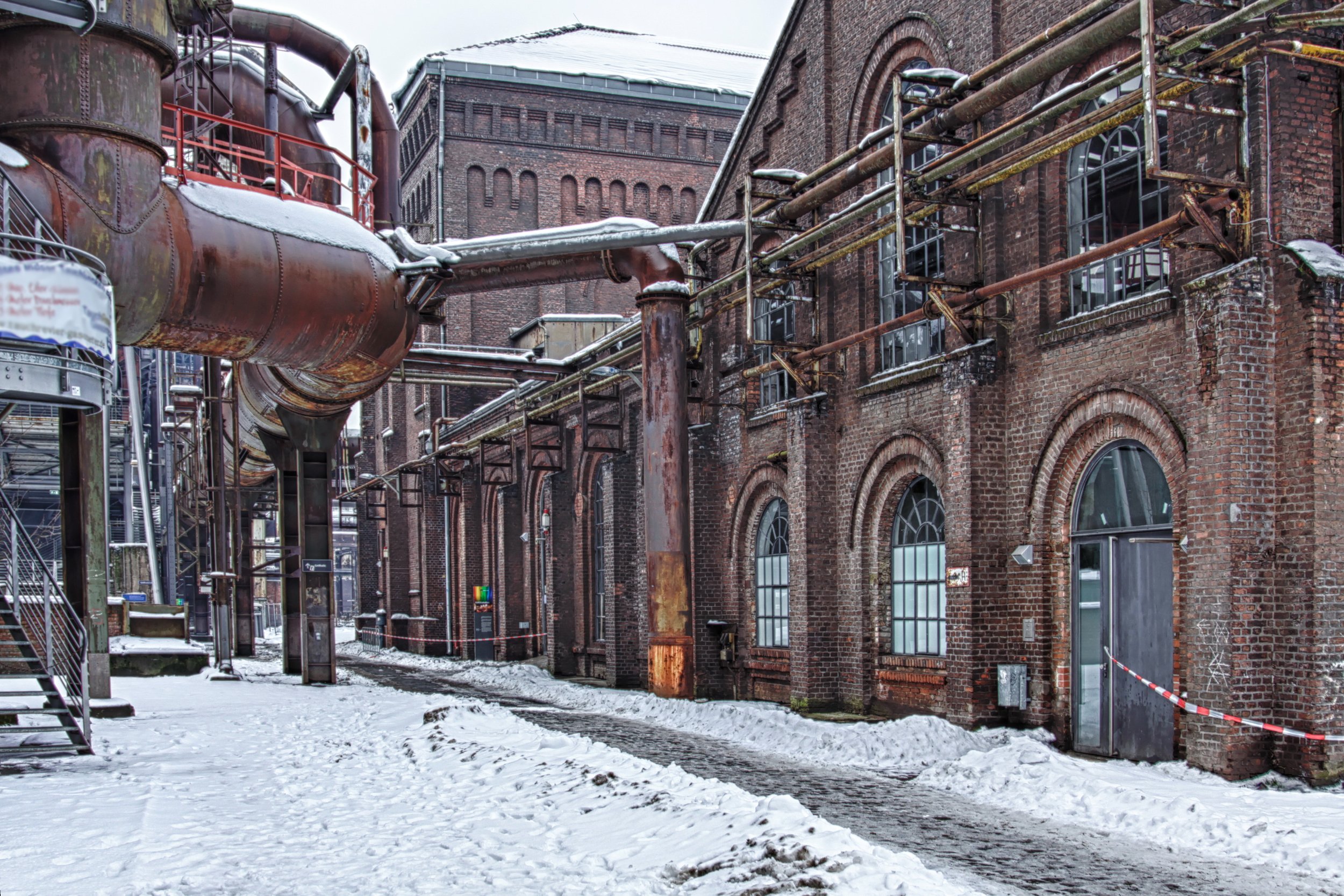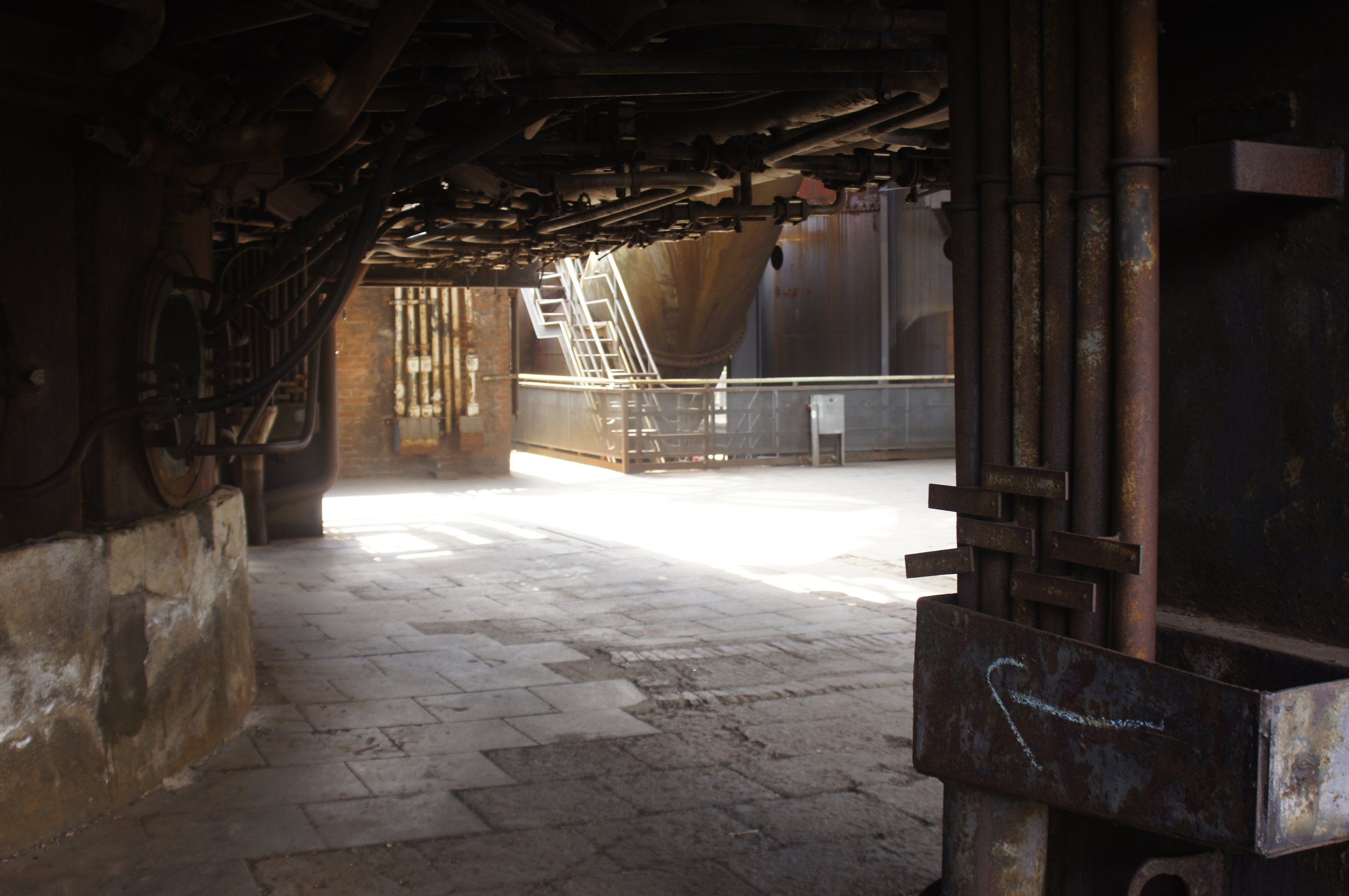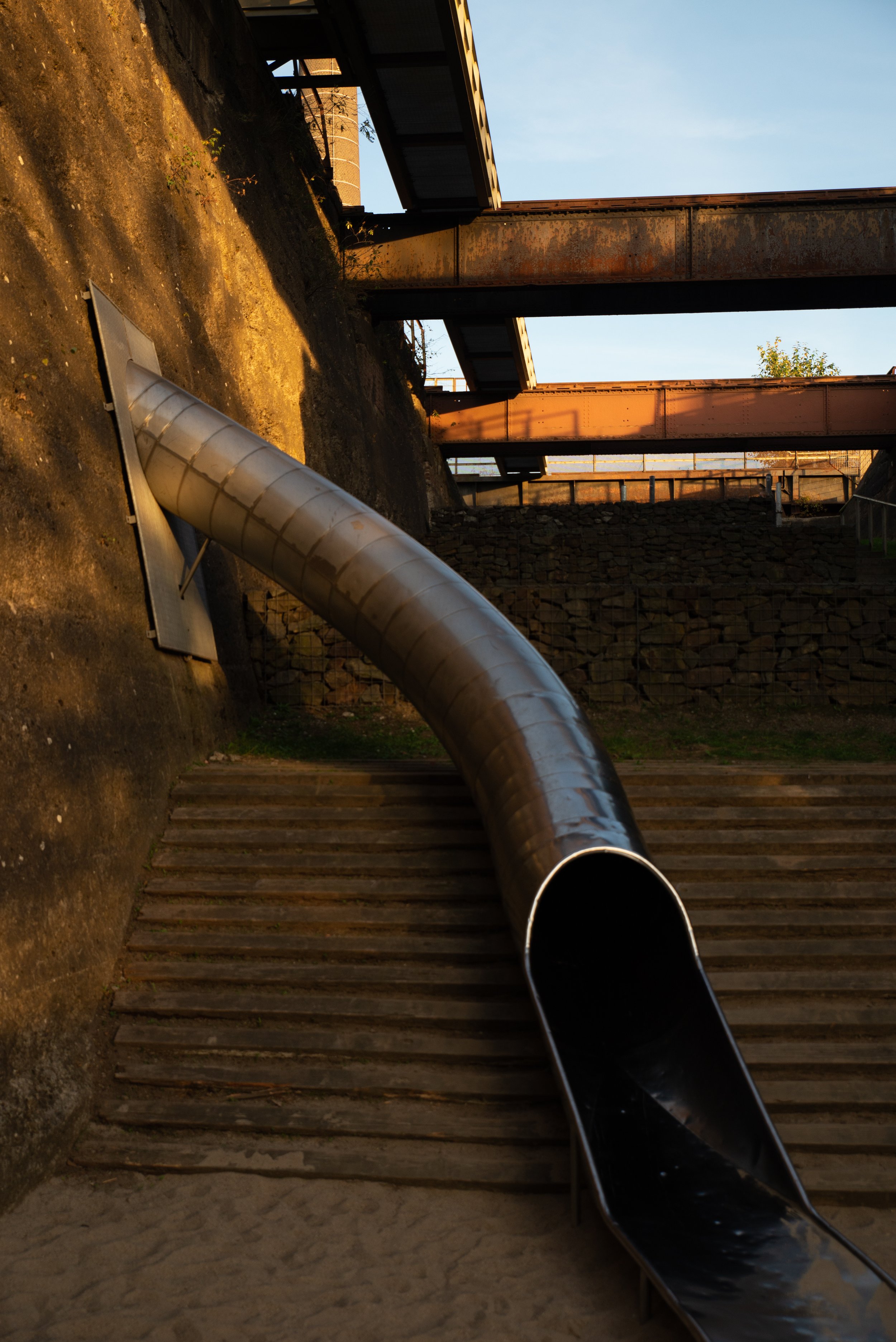
RESIDUAL SPACE: Reading Industrial Remains through Marxist Materialism and Ecological Discourse
School: Harvard GSD | Course: Theories and Practices of Landscape Architecture | Semester: Spring 2025
This paper examines Nord Duisburg Park, a public park created within the remnants of a decommissioned steelworks in Duisburg, Germany, through two theoretical lenses: Marxist theories of spatial production and the cultural construction of ecology. By engaging with these frameworks, the paper aims to uncover the layered and contested nature of the park as both a material and ideological landscape.
To showcase the layered meanings embedded in Nord Duisburg Park, this paper draws on a selection of texts that offer insight into both material and ideological dimensions of landscape. Robert Smithson’s A Sedimentation of the Mind and Frederick Law Olmstead and the Dialectical Landscape ground the analysis in a Marxist materialist approach that sees the park as a site of contradiction, where decay and regeneration coexist. Dipesh Chakrabarty’s The Climate of History in a Planetary Age situates the site’s industrial legacy within the broader planetary crisis of climate change, while David Demeritt’s critique of ecological science in Science, Social Constructivism and Nature reveals how environmental reclamation is often socially constructed. Finally, Raymond Williams’ Ideas of Nature offers a cultural critique of how “nature” is ideologically framed, particularly in post-industrial design contexts. Together, these texts allow for a reading of Nord Duisburg Park not as a neutral space of remediation or post-industrialism, but as a spatial artifact where capital, labor, and ecological discourse intersect.
Photo: Nord Duisburg Park. Credit: Adobe Stock Images
Nord Duisburg Park
Nord Duisburg Park is a well-known post-industrial public park, designed by landscape architect Peter Latz in the 1990s. The site was formerly part of the Thyssen steelworks, a large industrial mill that shut down in 1985 due to increased globalization. Rather than erasing the site's industrial past, Latz's design integrates remnants of the blast furnaces, rail tracks, and other steel-making infrastructure into a new ecological and recreational landscape. The park features reclaimed gardens, constructed wetlands, adventure playgrounds, and climbing walls, making it both a site of ecological remediation and public recreation. The park is internationally celebrated as “exemplary of the emergence of a new era of post-industrial parks.”1
Peter Latz envisioned the site as an altered ecological condition and jumped on this idea after noticing that vegetation succession had naturally begun after operations shut down. An effort was put forth to focus on ecological awareness while celebrating the site’s legacy. “Remnants of demolished structures were reused in planting substrates, recycled concrete, or new paving materials.”2 Many of the ecology interventions themselves focused on reducing maintenance costs and the site’s longevity. For instance, the river that once ran through the site was channelized when the steelworks were first constructed did not get “re-naturalized” as ecologists had recommended. “Nevertheless, they managed to reestablish its ecological functioning as habitat for aquatic plants and wildlife.”2 In addition, much of the vegetation growth on the site was a mix of native and exotic species, many of the exotics brought to the site through material transport over decades. This diversity of species accentuates the site’s industrial past and natural succession through ecological and visual cues.
Nord Duisburg Park reflects the broader ecological and aesthetic trends in post-industrial landscapes. The stories of these sites, of historical value, ecological reclamation, and aesthetic beauty of rust and steel, are romanticized in western culture. They operate as both a spatial product of capital and a constructed ecological narrative. Through the lenses of Marxist spatial theory and ecological dualism, the site is revealed not as neutral “green” remediation but as a layered ideological landscape that aestheticizes labor and stages nature.
Marxism and the Production of Space
Marxist theory of space, particularly as articulated by thinkers like Henri Lefebvre, argues that space is not a neutral, passive realm but is instead produced by social, political, and economic forces, especially those tied to capitalism.3 In this view, space reflects and reinforces the structures of labor, class, and capital. Urban parks, industrial zones, and “natural” landscapes are all spatial products shaped by ideologies and economic relations.
Robert Smithson, while not a Marxist per se, engages with space in a materially layered way that resonates with Marxist ideas. In “A Sedimentation of the Mind”, Smithson draws attention to the geological and entropic processes that shape land over time, suggesting that landscape is not static but layered with historical, material, and perceptual residues. His view that landscape is both a physical and mental construct aligns with the idea that space is historically produced and not simply found. Through these lenses, trends in aesthetic and culture can alter the way we look at layered sites and materials. “The products of industry and technology began to have an appeal to the artist who wanted to work like a “steel welder” or a “laboratory technician.” This valuation of the material products of heavy industry, first developed by David Smith and later by Anthony Caro, led to a fetish for steel and aluminum as a medium.”4
In “Frederick Law Olmsted and the Dialectical Landscape,” Smithson critiques the picturesque aesthetic of parks like Central Park, arguing instead for an understanding of landscape as a dialectical process, a dynamic negotiation between built form and natural decay, culture and nature, order and entropy. “…Olmstead’s parks exist before they are finished, which means in fact they are never finished; they remain carriers of the unexpected and of contradiction on all levels of human activity, be it social, political, or natural.”5 This aligns with a Marxist reading of space as a site of contradiction, produced through labor and shaped by economic structures.
Applied to Nord Duisburg Park, this theoretical framework allows the site to be read not as a resolved, rehabilitated green space, but as a materially contested landscape. The preserved ruins, decaying infrastructure, and staged ecological interventions expose the sedimented layers of industrial labor, ecological succession, and capitalist transformation. Rather than erasing its industrial history, the park makes visible the layers of production, decay, and spatial reimagination under a capitalist system and conceptualized aesthetic.
Collage: The Production of Space, by Nathan Sweitzer
Ecology as Science and Ecology as Nature
Ecology can be understood in two ways. Ecology as science is the data-driven study of ecosystems, species, and environmental processes, operating under objectivity and observation. Ecology as nature reflects how ecological ideas are culturally constructed and symbolically loaded. How “nature” is imagined and idealized within society. Ecology as nature is not just an ecological system but a site of meaning, ideology, and representation.
Dipesh Chakrabarty’s framework and David Demeritt’s critique of ecological science serve to argue against the park’s ecological narrative. Chakrabarty’s work in The Climate of History reveals how the industrial past of Nord Duisburg Park is linked to broader global environmental crises, particularly through the carbon emissions and ecological degradation linked to industrial production.
Demeritt’s critique of ecological construction uncovers the park’s “greening” process as not simply a neutral or technical intervention but as a political and cultural act. Through these lenses, the park’s ecological rehabilitation; phytoremediation, habitat restoration, and green infrastructure, becomes a socially constructed narrative that reimagines the park as a space of ecological recovery, even as it obscures the capitalist and industrial forces that shaped its original development.
Raymond Williams’ concept of nature as ideology highlights how the park’s transformation into a “green space” is more than an aesthetic gesture. It reflects a cultural construction of nature, one that erases the history of industrial labor and class struggle, replacing it with a romanticized vision of ecologically. The park’s narrative of healing through nature functions as a myth, obscuring the exploitation that once marked the site.
Space as Memory and Space as Symbol
Together, these theoretical frameworks allow the park to be read as a complete site where the forces of labor, nature, and capital remain in tension. Nord Duisburg Park functions as both a landscape of memory and a symbol of ecological reclamation. Yet rather than resolving the contradictions between its industrial past and post-industrial present, the park aestheticizes these contradictions, transforming historical material processes into visual and experiential narratives. The preserved blast furnaces, overgrown with vegetation and framed by scenic walkways, do not merely testify to the past, they are curated to evoke a specific affect: nostalgia, sublimity, resilience.
This visual aligns with what Raymond Williams identifies as the ideological framing of nature: the transformation of complex historical processes into consumable cultural symbols. “Ideas of nature, but these are the projected ideas of men. And I think nothing much can be done, nothing much can even be said, until we are able to see the causes of this alienation of nature, this separation of nature from human activity, which I have been trying to describe.”6 In this sense, nature becomes a screen onto which society projects its desires for redemption, healing, and progress. The park stages nature as both wild and controlled, spontaneous and designed, qualities that align with desire for picturesque ruin, while eroding the labor relations that once controlled the site.
Following Lefebvre, the park also is an example of representational space, a lived and imagined site that represents ideology in physical form. As Lefebvre explains, “representational spaces are directly lived through their associated images and symbols, and hence the space of ‘inhabitants’ and ‘users’”7 The celebration of ecological succession and sustainability overlays what Smithson calls the “entropic” reality of industrial degradation. Nord Duisburg Park risks offering a myth of ecological recovery that obscures the systemic issues it emerges from, industrialization and capitalist development.
The park can then be read as a layered artifact, one that both reveals and conceals its historical conditions. The layering of decayed infrastructure with new ecological systems may seem to embody resilience, but it also facilitates the change of industrial ruin into cultural capital. This aligns with Chakrabarty’s critique of how the planetary consequences of industrial modernity are often domesticated into local narratives of green renewal. “Why should one include the poor of the world, whose carbon footprint is small anyway, by use of such all-inclusive terms as species or mankind when the blame for the current crisis should be squarely laid at the door of the rich nations in the first place and of the richer classes in the poorer ones?”8 What remains unaddressed is the deeper contradiction: that the Anthropocene condition cannot be resolved through site-specific greening, because it is a structural crisis of capital and history, not merely a spatial or ecological problem.
Nord Duisburg Park is not alone in its aesthetic and ideological tone, it belongs to a global mass of post-industrial landscapes that reframe ruins as public assets. In New York, the High Line converts abandoned rail infrastructure into elevated promenades flanked by native grasses and luxury real estate, transforming a once-industrial corridor into a playground for capital. Similarly, Gas Works Park in Seattle overlays toxic soil and industrial remnants with recreational leisure, offering panoramic views and curated rust and steel. These examples show divergent strategies of memory and land use, yet the common thread is the tendency to romanticize industrial remnants and foreground ecological renewal over critical thinking. This cultural shift often privileges affect, like nostalgia, awe, and serenity, over critique. Landscapes like Nord Duisburg Park thus risk becoming not challenged but capitalistically consumed. In this sense, the park isn’t a radical intervention but a spatial compromise, one that neatly contains the unsettling legacy of industrial modernity within a properly packaged form.
Conclusion
What would it mean to design a post-industrial landscape that resists aesthetic popularity? One that centers labor history and structural critique, rather than nostalgia and green ideology? Such a project might forgo the picturesque layering of ruin and vegetation in favor of more radical interpretive tools: permanent exhibitions of why the park is not a legitimate climate change intervention, spatial markers of past exploitation, or interventions that expose toxic histories rather than hide them. While Latz’s design is widely praised for its innovation and ecological foresight, it also raises difficult questions about the role of landscape architecture in reproducing common ideologies. Can the language of design speak to the issues of industrialization without rendering it beautiful? Can spaces of past production be preserved without being consumed or capitalized on? These are not questions with simple answers, but they are essential if we are to move past the aesthetics of resilience toward a new view of memory and justice.
1. Stilgenbauer, Judith. 2005. “Landschaftspark Duisburg Nord - Duisburg, Germany [2005 EDRA/Places Award -- Design].” Places, 6.
2. Stilgenbauer, Judith. 2005. “Landschaftspark Duisburg Nord - Duisburg, Germany [2005 EDRA/Places Award -- Design].” Places, 9.
3. MAKINDE (PhD), Olusola Oladapo, and Amao Funmilayo Lanrewaju (PhD). 2024. “Henri Lefebvre Theory of Space and Social Production Philosophy: A Critical Interpretation.” Global Journal of Arts Humanity and Social Sciences 4 (1): 67–80. https://doi.org/10.5281/zenodo.10577092.
4. Smithson, Robert. 1968. Review of A Sedimentation of the Mind: Earth Projects, 86.
5. Smithson, Robert, and Frederick Law Olmsted. 1973. Frederick Law Olmsted and the Dialectical Landscape, 119
6. Williams, Raymond. Ideas of Nature: Theoretical and Political Perspectives. 1980, 82.
7. Lefebvre, Henri. The Production of Space. Translated by Donald Nicholson-Smith. Oxford: Blackwell, 1991.
8. Chakrabarty, Dipesh. “The Climate of History: Four Theses.” Critical Inquiry 35, no 2 (2009): 197-222.






